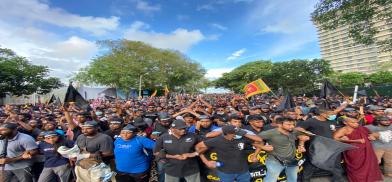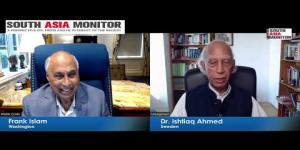Sri Lanka's Gota Go Gama protests: Creating a new space for religious and ethnic diversity
Gota Go Gama became a new political and cultural metaphor with numerous dimensions. It was a turning point for Sri Lanka that contributed to creating a new space for diversity.

‘Gota Go Gama’ is a series of protests that started in Sri Lanka because of the refractory economic and other policies of the previous Rajapaksa regime. The root causes for this political turmoil and economic crisis have a long story. Anger over the economic crisis, corruption, and the government's handling of the situation led to weeks of protests all over Sri Lanka demanding that President Gotabaya Rajapaksa and his regime step down from power. Since March 2022, the protests spread across the country with different slogans like "Go Home Gota", "Go Home Rajapaksas", and so forth.
The author argues that Gota Go Gama - the name given to the main protest site in Colombo at the iconic Galle Face Green - has become a new sphere of diversity. As Ferris University stated diversity is the range of human differences, including but not limited to race, ethnicity, gender, gender identity, sexual orientation, age, social class, physical ability, or attributes, religious or ethical values system, national origin, and political beliefs. This explains that under diversity people from a range of backgrounds and settings are included. The author argues that diversity and inclusion are the key characteristics that can be seen throughout the recent protests in Sri Lanka.
Protest attendees in Sri Lanka were racially and ethnically diverse. We saw Sinhalese, Tamil, and Muslims participating in protests that took place all over Sri Lanka. During the Sinhala and Tamil New Years, we observed how all ethnicities came together to celebrate it. Muslims and Sinhalese sat together and ate during the period of Ramadan. They shared their cultures and opened to new cultural experiences. Due to the ethnic splitting created by the hidden agendas of some parties, there were ethnic-related tensions among ethnicities in Sri Lanka.
Since the protest started in Sri Lanka, it was noticed that ethnic lines and religious misperceptions had begun to fade away. Due to the Easter Sunday attack, there were lots of misconceptions revolving around Muslim people. A pre-planned sudden attack was launched by the Rajapaksa regime against the peaceful protestors in Gota Go Gama. Because of this unexpected incident, tensions erupted in the Negombo area. Negombo is a Colombo suburb that has multicultural dimensions. A group of people has attempted to attack a few shops and it was alleged to be an attack launched by Muslims. As per evidence, it was an incident instigated by the then government with the aim of creating misconceptions among different ethnicities. But the protestors did not get affected by this aggressive incident and tensions generated aimed against Muslims disappeared.
Inclusiveness of protesters
Religious inclusion is one of the key dimensions of protests in Sri Lanka. During the Vesak celebrations, we experienced how Catholic priests and Catholic sisters participated in Dhana puja (Dhana is a practice of giving food to Buddhist monks). Further, the Catholic sisters came together and aligned as a shield to protect the protestors. The instances indicate how ethnic and religious separations dissolved during the protests in Sri Lanka. which hopefully is the start of a positive social trend.
Protestors came from various economic settings and economic backgrounds. Low-income, middle-income, and high-income people participated in protests voicing their economic concerns. Labourers, farmers, drivers, teachers, lawyers, university lecturers, celebrities, cricketers, and many more gave their fullest support to the protests. There were no economic divisions that prevented people from paticipating in the protests. There weren’t any gender divisions or age restrictions; we saw how men and women came together to address the economic and political problems in Sri Lanka. Even children and older people participated in protests by holding up placards. A man carried a child on his shoulder during the anti-government protests near the president’s office.
Youth participation was a decisive part of the anti-government protest. Antharaya (an association created by university undergraduates) played a crucial role in organizing and demanding that the president and his regime step down. Gota Go Gama became a new political and cultural metaphor with numerous dimensions. It was a turning point for Sri Lanka that contributed to creating a new space for diversity.
(The author is an Assistant Lecturer, Department of International Relations, University of Colombo, Sri Lanka. Views are personal. She can be contacted at sandamali@inr.cmb.ac.lk)














Post a Comment